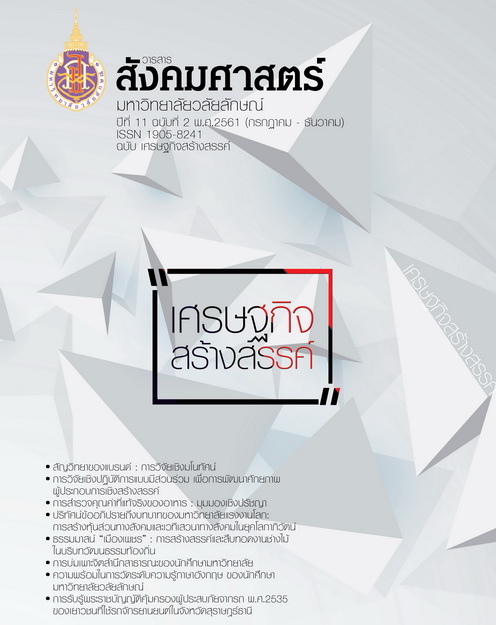Phetchaburi Preaching Canopies: Dynamic of Traditional Woodcraft Culture in Local Cultural Context
Main Article Content
Abstract
The article investigates the dynamic of Phetchaburi traditional woodcraft schools in the most popular period (1857-1957) called “traditional craftsmanship in the period of bourgeois’ fostering”. I used preaching canopies as a part of woodcraft popularity collaborated with other craftsmanship as much still prevailing in local areas. Through fieldwork surveys and data collection in the core city of Phetchaburi and outer cities, I found more than 50 preaching canopies, which suggests a huge stream of Buddhism crafts. Traditional woodcraft of Phetchaburi schools was flourished under particular cultural, economic and social conditions. The four significant traditional woodcraft schools in Phetchaburi include Wat Yang, Wat Koh, Wat Phra-throng, and Wat Phlapphlachai. I argue that economic and social conditions, especially the changing faces of education and labor market in Phetchaburi capital city have been the major factors affecting the art existence and determining the dynamic of woodcraft culture in local contexts from the high prosperity in the beginning to the decline of Phetchaburi work of art in the present day.
Article Details
Copyright: CC BY-NC-ND 4.0
References
Atsawinanon, N. (1992). The Social and Economic Changes of Phetchaburi Capital (1857-1917 A. D.). (Master’s Thesis). Bangkok: Chulalongkorn University.
Chaemchan, B. (1992). Phetchaburi Craftsman: a Memorial to the Cremation of Asst. Prof. Bua Thai Chamchan. June 21, 1992. Phetchaburi: Petchpoom Press.
Infasaeng, D. (1999). A study on the Development of Phetchaburi Local Arts: a Case Study of Pin In Fah Sang. (Master’s thesis). Bangkok: Mahidol University.
Kongkirati, P. (2013). And then the Truth Appears: Cultural Politics of 14 October’s Students and Intellectuals. Nontaburi: Sameskybooks Press.
Lungrung, S. (2001). A Study of Phetchaburi Temporary Crematory to Design a Temporary Crematory that is Suitable for the Present Condition. (Master’s thesis). Bangkok: Chulalongkorn University.
Macharoen, C. (1977). Preaching Canopy. Fine Arts Department: Ministry of Education.
Na Paknham, N. (2001). Preaching Canopy: Dignity of Art. Bangkok: Muang Boran Press.
Nawigamune, A. (2011). Siamese craftsman. Bangkok: Satapornbooks.
Persons, L. S. (2016). The Way Thais Lead: Face as social Capital. Chiang Mai, Thailand: Silkworm Books.
Phetcharopamakhun. (2000). History of Wat Koh. In Phiboonsombat, B. (Ed.). Wat Koh, Phetchaburi. Phetchaburi: Petchpoom Press.
Phetchplod, P. (1988). Crematory of Phetchaburi Schools. (Master’s thesis). Bangkok: Silpakorn University.
Prakitnonthakan, C. (2017). Origins of Siamese Architects: Identity, Role and Power in Modern Society. Ratthasat San, 38(1), 29-108.
Sinsert L. (2006). Analysis of the Phetchaburi Stucco Schools Pattern. (Master’s thesis). Bangkok: Srinakharinwirot University.
Susayan, U. (2009). The Change of the Common System and the Impact on Thai society During the Reign of King Rama V. Bangkok: Sangsanbooks.
Sukroengpaeng, N. (1987). Wat Yang Sermon Hall. In B. Piboonsombat (Ed.). Memorial to the Cremation of Phra Thep Vajrayana (Intra Into Shot]. Phetchaburi: Chuan Pim Press.


